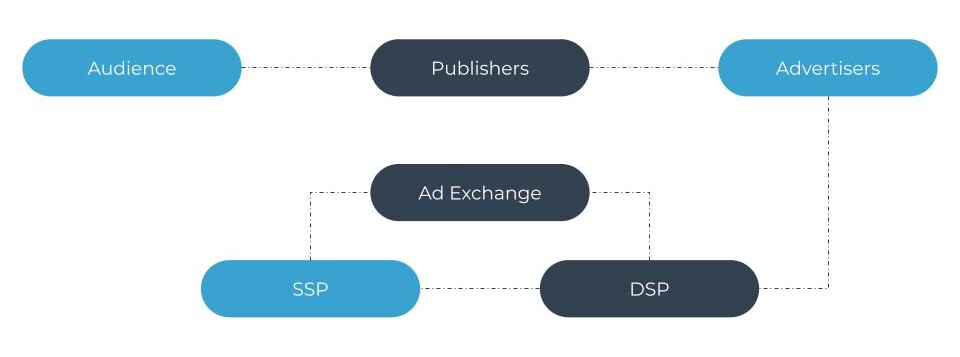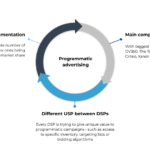April 22, 2023
by AdsLinkers
Share
Programmatic advertising has become a cornerstone of digital marketing. It allows advertisers to buy, sell, and optimize ad inventory in real-time through data-driven targeting and automated bidding. Demand-side platforms (DSPs) are at the heart of this revolution. Providing marketers with the tools and resources necessary to execute effective programmatic campaigns. In this ultimate guide, we’ll delve into the possibilities offered by various DSPs. Including their targeting capabilities, inventory options, advantages, disadvantages, and costs.

Display & Video 360: Google’s Comprehensive Solution
Display & Video 360 (DV360) is Google’s unified platform for programmatic advertising, offering end-to-end campaign management across display, video, native, and more.
Key features
- Targeting Possibilities: DV360 provides granular targeting options. These are demographic, geographic, contextual, and behavioral targeting, as well as custom audiences and lookalike modeling.
- Inventory: Access premium inventory across Google’s ad exchange, YouTube, and Google Ad Manager. You can well as third-party ad exchanges and direct deals with publishers.
- Advantages: Seamless integration with other Google products, advanced targeting options, robust reporting and analytics, and access to premium inventory.
- Disadvantages: Higher costs compared to other platforms and limited support for smaller advertisers.
- Costs: DV360 operates on a percentage-based fee structure, with fees typically ranging between 10% and 20% of the media spend.
The Trade Desk: A Powerful, Independent DSP
The Trade Desk is a leading independent demand-side platform (DSP) that offers a data-driven approach to programmatic advertising. Key features include:
Key features
- Targeting Possibilities: The Trade Desk provides a wide range of targeting options, including demographic, geographic, contextual, and behavioral targeting, as well as custom audiences, first-party data integration, and lookalike modeling.
- Inventory: Access to a vast inventory pool from premium publishers, ad exchanges, and supply-side platforms (SSPs), as well as support for private marketplaces and direct deals.
- Advantages: A powerful and user-friendly interface, extensive third-party integrations, advanced targeting options, and a strong focus on transparency and brand safety.
- Disadvantages: Limited support for smaller advertisers and higher costs compared to other platforms.
- Costs: The Trade Desk operates on a percentage-based fee structure, with fees typically ranging between 10% and 20% of the media spend.
MediaMath: A Pioneer in Programmatic Advertising
MediaMath is an industry-leading DSP that has been at the forefront of programmatic advertising since its inception.
Key features
- Targeting Possibilities: MediaMath offers a wide range of targeting options, such as demographic, geographic, contextual, and behavioral targeting. There is also posibbility to target first-party data integration and lookalike modeling.
- Inventory: Access to a diverse inventory pool from premium publishers, ad exchanges, and SSPs, as well as support for private marketplaces and direct deals.
- Advantages: An established and reliable platform with extensive third-party integrations. Besides that there are advanced targeting options, and a strong focus on transparency and brand safety.
- Disadvantages: A steeper learning curve compared to other platforms and higher costs for smaller advertisers.
- Costs: MediaMath operates on a percentage-based fee structure, with fees typically ranging between 10% and 20% of the media spend.
Adform: A Flexible, Full-Stack Platform
Adform is a full-stack programmatic platform that provides an integrated solution for ad serving, data management, and demand-side platform (DSP) capabilities.
Key features
- Targeting Possibilities: Adform offers a wide range of targeting options, including demographic, geographic, contextual, and behavioral targeting, as well as first-party data integration and lookalike modeling.
- Inventory: Access to a vast array of inventory from premium publishers, ad exchanges, and supply-side platforms (SSPs), as well as support for private marketplaces and direct deals.
- Advantages: A comprehensive full-stack solution, flexible pricing options, and a strong focus on transparency and brand safety.
- Disadvantages: Steeper learning curve compared to other platforms and less extensive integration with third-party tools.
- Costs: Adform’s pricing model varies based on the services used, with options for CPM-based fees, flat-rate fees, or percentage-based fees.
Criteo: The Retargeting Specialist
Criteo is a global technology company that specializes in retargeting and personalized advertising.
Key features
- Targeting Possibilities: Criteo focuses on retargeting, using machine learning algorithms to serve personalized ads based on a user’s browsing history and interests.
- Inventory: Access to a vast inventory pool from premium publishers, ad exchanges, and SSPs, as well as support for private marketplaces and direct deals.
- Advantages: Advanced retargeting capabilities, performance-based pricing model, and a strong focus on transparency and brand safety.
- Disadvantages: Limited targeting options outside of retargeting and a less user-friendly interface compared to other platforms.
- Costs: Criteo operates on a cost-per-click (CPC) pricing model, which means advertisers only pay when a user clicks on their ads.
Xandr: Microsoft’s Advanced Advertising Platform
Xandr, formerly known as AppNexus, is Microsoft’s advanced advertising platform that provides a suite of solutions for mainly video programmatic advertising
Key features
- Targeting Possibilities: Xandr offers a wide range of targeting options, such as demographic, geographic, contextual, and behavioral targeting. There are also first-party data integration and lookalike modeling.
- Inventory: Access to a diverse inventory pool from premium publishers, ad exchanges, and SSPs, as well as support for private marketplaces and direct deals. Only partner with access to Netflix’s inventory.
- Advantages: A powerful platform with extensive third-party integrations. Advanced targeting options are available, and a strong focus on transparency and brand safety.
- Disadvantages: A steeper learning curve compared to other platforms and limited support for smaller advertisers.
- Costs: Xandr operates on a percentage-based fee structure, with fees typically ranging between 10% and 20% of the media spend.
Conclusion

Programmatic advertising, powered by DSPs such as Display & Video 360, The Trade Desk, MediaMath, Adform, Criteo, and Xandr, is essential for maximizing digital marketing campaign performance and return on investment. By evaluating each platform’s offerings, such as targeting capabilities, inventory options, user-friendliness, pricing, and commitment to transparency, brand safety, and data privacy, marketers can select the right DSP for their objectives and budget. Moreover, as omnichannel marketing gains traction, leveraging the right DSP allows for the seamless integration of highly targeted campaigns across multiple platforms, ensuring a consistent and relevant customer experience at every touchpoint.







